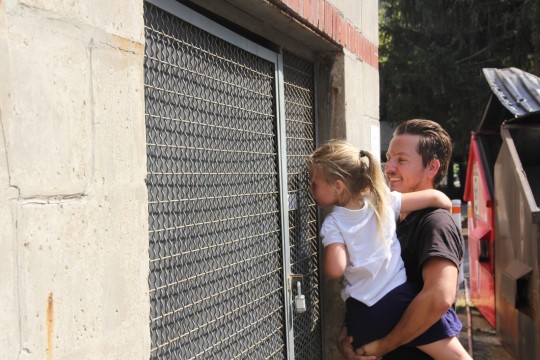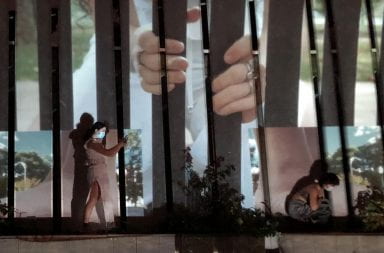
Master’s candidate Adrian Waggonner shows his daughter the projection work of fellow artist Lillianna Marie on Aug. 26, 2014. Her work, entitled “Refrain,” is observable only through a peephole on a shed outside Ramseyer Hall.
Credit: Daniel Bendtsen / Asst. arts editor
Often, artwork can be isolated inside, bound to galleries and museums. That tendency was one the master’s of fine arts candidates at Ohio State fought to break this year.
Contributing artist Lillianna Marie said this is the first time the MFA second-years diffused their works around campus and the city. Typically, all the works are clumped together in one gallery.
The title of the exhibition, “The Instant Now,” reflects the one thing all artists share, contributor Bill Randall said.
“As artists, we all work in really different disciplines, so there’s not necessarily a theme you can draw out of the work. But there’s one thing we all share, and that’s a moment,” he said. “For painters, it’s the moment before you touch the canvas and you don’t know what you’re going to do yet. At that moment, theoretically, anything is possible. Once you’ve made a mark, that determines everything else. So, really, this project is a snapshot of where we are now. It’s a cross-section of our practice.”
Having the work of 14 artists in different locations will help the art department become more connected with the rest of campus, Randall said.
“Geographically, this has to be one of the biggest universities in the world, and (it) has so many different departments,” he said. “We are here for such a short period of time. It’s a three-year program, so we just wanted to reach out and make some connections.”
The students also developed a new student organization called Mirage Gallery, which aims to continue on the practice of using unusual exhibition locations in the future.
Randall’s work entailed creating dozens of clear acrylic objects and placing them in various locations around the city of Columbus.
“It’s kind of like litter. I’ve crafted these objects and placing them around in places where they aren’t necessarily wanted, but, of course, they’re all perfectly harmless,” he said.
He said he hopes that placing foreign objects in uncommon locations will give him information about how people interact with them.
“I have an interest in mapping, and I’m interested in site-specific works where a person responds to a space. I’m hoping to have about 50 locations, and I can go back at the end of the piece and try to recollect to see if any are still there,” he said.
The placement of works in public locations can also come with risks. Marie said her projection piece — located inside of an on-campus storage shed — has already been vandalized, even though the display only opened Tuesday.
Another artist, Jonathan Capps, took a cast-iron bathtub and placed it in the Chadwick Arboretum Lake. He filled it with hand-blown glass spheres, creating the illusion of a bubble bath.
Maria DiFranco’s work, located in the Fine Arts Library, came from an accidental inspiration.
She traveled through several European countries over the summer, including Italy, France, Spain and the United Kingdom. She collected postcards along the way with the intent of sending them to friends and family back home. Once she found out it would cost 2 euros each to send them back, she brought the postcards home to turn them into an exhibit.
“Each day, I’ll take one down and do a drawing on the back with one of my stories from Europe, and eventually then mail them out domestically to the different people,” she said. “It’s fun because it’s this archive of Europe but also so tied to the American experience there.”
The work by Julie Rae Powers came from her hometown experience in West Virginia. Her photo gallery on High Street shows the complexities of the day-to-day work ethic of coal miners in West Virginia, she said.
“My family has three or four generations of coal miners, and I was interested in their allegiance to that field, especially because it’s such a politically hot topic,” she said. “It’s such a daunting task to get up each day and work in a mine. It’s hard work and risky work, yet the economics of the area make it one of the higher paying jobs. A lot of people risk their lives to provide for their family.”
Not all artists took on such a serious topic. Jessica Ann took a lighter tone and filled a large studio space with used lingerie floating from helium balloons.
“It’s kind of a funny piece and is next to a video piece by Kyle Downs that’s equally as playful,” she said. “Mine took a lot of work. It takes 15 balloons to float one piece of lingerie, so we’ll see how my bank account looks at the end of this. I might have to take out a student loan for floating lingerie.”
“The Instant Now” is on display in various locations until Sept. 12.


